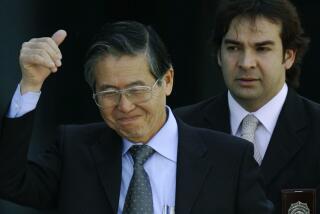Siege in Lima May Be the Last Stand of Rebels in a Decimated Movement
LIMA, Peru — Even before they were cut down by the bombs and bullets of special forces troops in the Japanese ambassador’s residence, the small platoon of leftist rebels who held Peru hostage for more than four months were walking ghosts.
The audacious takeover of the mansion by the Tupac Amaru Revolutionary Movement, or MRTA, in December generated global attention that was far out of proportion to a guerrilla movement that had few fighters and minimal popular support. The Tupac Amaru had been decimated by arrests, deaths and a slide into ideological confusion and crime for profit.
Except for Nestor Cerpa Cartolini, the glowering die-hard who staked everything on one last offensive, the platoon consisted mainly of teenagers from remote jungle villages. They were athletic, determined and sadly deluded. Some complained to hostages that they had been told the siege would last no more than two weeks.
During the ensuing months, the youthful rebels lived in a surreal limbo. They avidly watched television soap operas. They studied Japanese with their captives. They organized a soccer league and played heated games in the cavernous living room. They wistfully asked the hostages about the beaches of Cuba, where they expected to travel in triumph as soon as the Peruvian government capitulated to their demands that fellow leftists be released from prison.
In the end, despite their bravado, prowess and heavy weaponry, the rebels let down their guard. Cerpa had publicly denounced the authorities weeks ago for digging tunnels beneath the residence. But when commandos erupted out of the floor in a blaze of smoke and gunfire, he and his lieutenants were playing an exultant game of soccer beneath the chandeliers of the luxurious fortress that became their tomb.
“What would have possessed them to have such lax security?” asked a foreign diplomat monitoring the crisis. “They themselves said they knew the tunnel was there. There were a lot of young people in that group, a lot of first-timers.”
The apocalyptic finale deprives the Tupac Amaru of its last field general and leaves the smaller of Peru’s two main terrorist groups on the verge of extinction, according to experts.
“Now they don’t have the possibility to put together a force that can take on the state or put together a strategy of power,” said Jaime Antesana, an analyst of Peruvian rebel groups. “It’s difficult to imagine that the MRTA will reappear in three or four years. . . . A few nuclei remain, but they won’t represent a danger for the nation. With Cerpa, one of the last important leaders of the movement has died.”
Cerpa’s takeover of the reception at the ambassador’s residence stunned Peru because it came a year after police rounded up a group of Tupac Amaru leaders, foiling a plan to take over the Peruvian Congress.
After the police roundup, Cerpa promptly poured arms and money--earned from years of lucrative kidnappings--into a new plan that became the December operation. And his dogged insistence on the release of Tupac leaders from prison--apparently to resurrect the movement--seemed increasingly disconnected from reality as the siege wore on.
“This act didn’t represent an MRTA movement in recomposition or in a political offensive,” Antesana said. “It was only an act. The country’s mood was on the other side. It rejects ever more strongly this type of activity.”
The remnants of the Tupac Amaru are thought to consist of perhaps 100 militants, concentrated in jungles in the province of Junin, northeast of Lima.
The only noted leader who is not dead or behind bars is the elusive Hugo Avelleneda. He is more of an ideologue than a Cerpa-style combat specialist, a veteran of the group’s 1980s heyday.
Like Cerpa and Tupac’s imprisoned founder, Victor Polay, Avelleneda belonged to a faction that split with the traditional Peruvian left and took up arms. He has been spotted in Panama and Ecuador.
Asked Wednesday if the Tupac Amaru was dead, President Alberto Fujimori responded: “Not necessarily.” But he said police are hunting for Avelleneda and Tupac “terrorists without leadership in the coca-growing areas.”
Despite the weakened state of the Tupac Amaru and of the larger and more vicious Sendero Luminoso, or Shining Path, the Fujimori administration is expected to stay on the alert for new terrorist acts. The president has experienced firsthand the damage that a fading guerrilla movement can do, even if it is doomed.
“The Tupac Amaru was always small,” the foreign diplomat said. “And it has gotten much much smaller. That is not to say there aren’t people with weapons who can cause problems.”
Times staff writer Mary Beth Sheridan in Lima contributed to this report.
More to Read
Sign up for Essential California
The most important California stories and recommendations in your inbox every morning.
You may occasionally receive promotional content from the Los Angeles Times.










